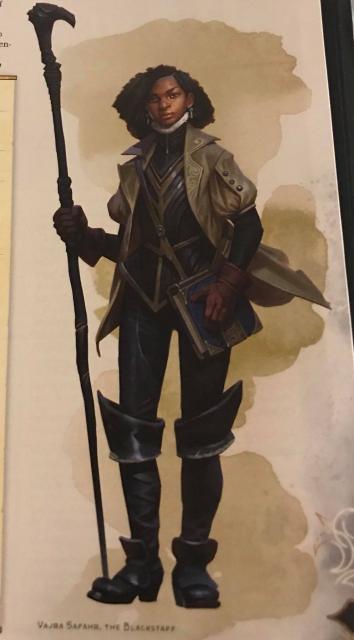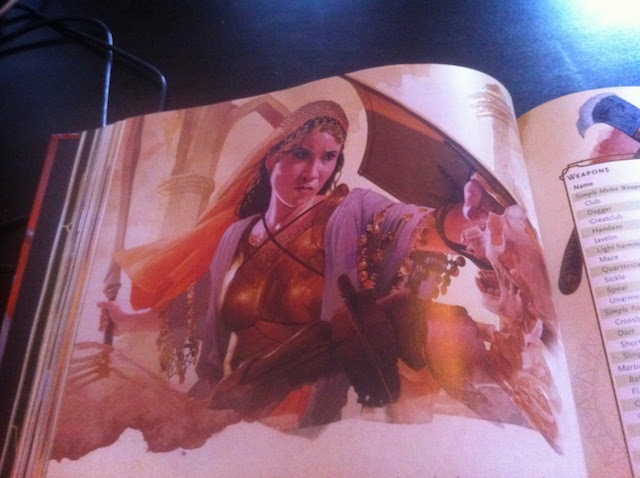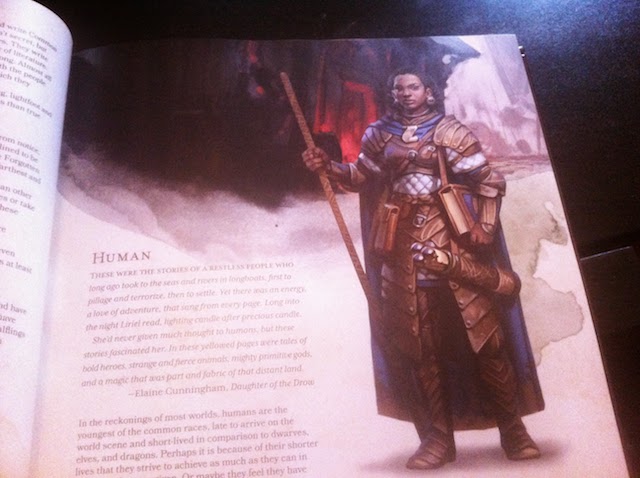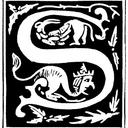Female Representation in D&D Art
So I'm going to talk about some stuff and given the reaction to my attempts to convey my point of view in the past, I know this might ruffle some feathers. What I'd like to ask is that if you continue to read and find that your feathers are feeling a little ruffled, maybe take some time to think about why that is before putting me on Internet blast? And if you don't think that you are willing to do that, please feel free to enjoy some of the other absolutely wonderful content available to you on the Internet.
 ©Wizards of the Coast
©Wizards of the Coast
With that out of the way, I'd like to talk about a topic that is near and dear to me, and that is female representation in game art. I know I've had a lot of discussions about that in the past but there's something different about today versus then. That difference is some changes that were made by some companies (particularly Wizards of the Coast) in terms of how they approach art in official Dungeons & Dragons publications.
My position has always been that the art of female characters has been way too restricted and lacked diversity. There was an overabundance of female characters within a narrow body type and age window, often (but not always) sexualized, often with an appearance that the references used were from lingerie or porn. While some interpreted that as an argument against any representation that fit those categories, that has never been my intent or what I argued.
As I talked to folks about this, especially folks in the industry, a few reasons for this kept coming up again and again. I'd like to talk about those because I think they amplified together to create the situation we had.

One of the first was that the reason for the characters being drawn with those references is that artists prefer to work from the naked form. In some ways, this is absolutely true. We know that many of the masters have worked from nude models. Knowing the physical structure of the subject of a work helps ensure that their back doesn't look awkward or broken. I get that.
But many of the masters used both male and female models. And while they did many works that involved their particular muse and often spent time on projects that pleased them, they produced many other works with a variety of subjects. But in the art at the time, it was clear from many of the male characters that no one was looking at nude or semi-nude references for them. No ads or photo shots of men in their boxers. Not really even swimmers or male ballet dancers. There was a noticeable imbalance in how many of the artists were approaching gender.
One way to approach adjusting that would be to try to increase the diversity of the artists that were hired, finding artists who were passionate about drawing men for instance, that could not be the only solution. The other most common reason I was told for why the art was the way it was is because that's what the artists thought art directors wanted. So, basically, the art director would give out assignments. They might even be explicit about what they were and were not looking for. But artists, being concerned about having artwork rejected, would give them what they thought they wanted, what they thought "fantasy art" meant.
So, instead of taking risks, they looked at what had already been created and did more of that. This often translated to folks as cheesecake art. Do to how the art process works, it wouldn't become clear to the art director that this was going to be the case until the final work was submitted, at which point it was too late to reject the work.
Why? Because initial "drafts" of the work are like outlines. The artist provides a thumbnail of the piece, more demonstrating the overall composition, the lines of movement, etc. Clothing, especially boob windows, and the like, wouldn't necessarily show up at that level. So the thumbnail gets approved and suddenly what one person might interpret as an older woman or a full cloak turns out differently in the final piece. And by then, so much work has been put in that it's hard to change.
The sad part about this particular reason is that it was a bit of a death spiral. With more and more work being put out in this style, it worked to further establish it as the style. And without taking a step back, everyone's reactions are understandable. The problem can be understood but not addressed.
So, what changed? Well 5e came out. And with the new edition came a new approach.

While I've been talking about this in terms of female representation, it wasn't just gender that was unbalanced. Skin tones were another big area as well as getting just a consistent understanding of how characters looked in a fantasy world.
With 5e, Wizards of the Coast decided not to go with a generic fantasy world for the base world. They chose the Forgotten Realms which at least had something closer to gender equality and a variety of skin tones for human characters (among others). It also had a variety of cultures within the world, with different ways of dress and speech. They could now tell artists, draw a person from this defined culture, rather than asking for a character in the fantasy style.
And that's what they did. They created world bibles and worked directly with concept arts to develop and refine what various cultures should look like on the page. They did this not just for male and female representations, but what did a family look like? What about older people in the village or city? So on and so forth.
The result was a wide range of art to choose from and the ability to "show, not tell" artists what these various groups looked like. While they still run into some issues with artists who draw boob windows on female characters from a culture that wouldn't have them (some cultures would!), those issues are far less. I haven't asked, but my guess is that they still might accept those pieces and adjust how they work with that artist in the future, but that piece that say sexualizes the character would be balanced out by the rest of them.
From my point of view, this has been a great breath of fresh air into D&D. I love seeing the greater diversity in the art. Of course there are still things to discuss and, in my opinion, improvements that can be made, but I look forward to looking at the art now. And I've seen so many positive responses from other folks out there.
Send feedback using the contact form or through twitter, @sarahdarkmagic.
